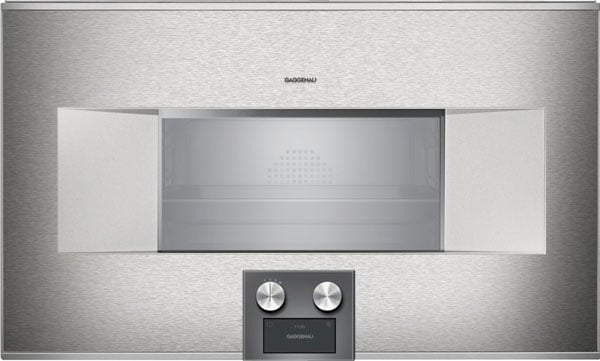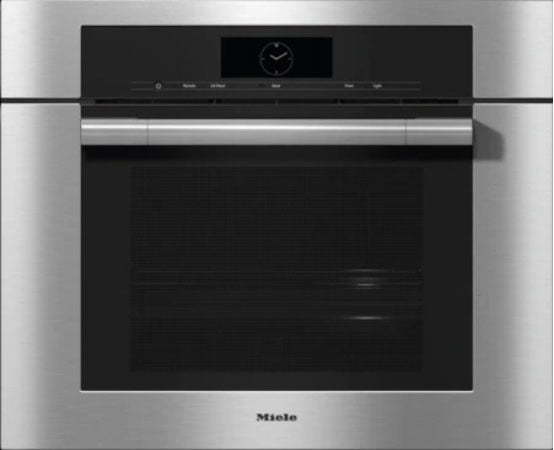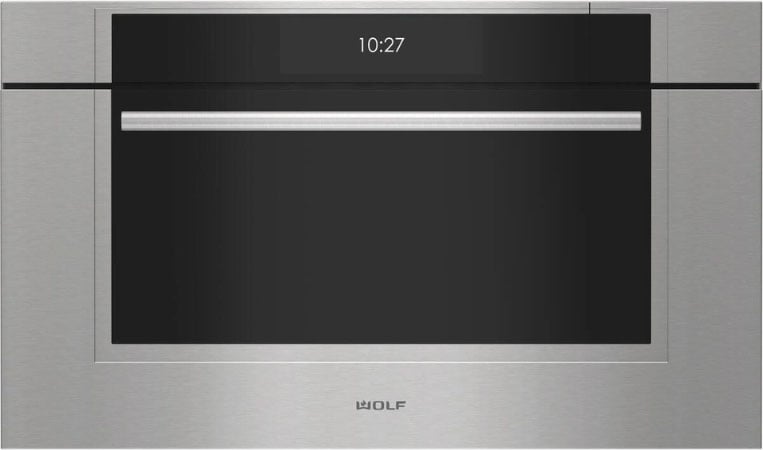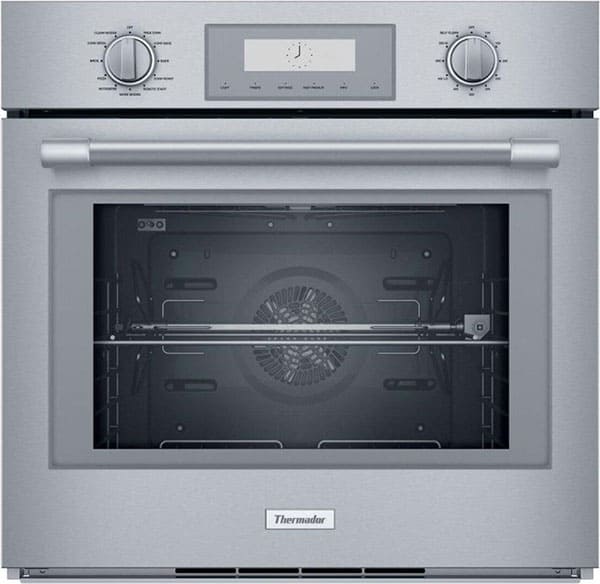The Best Steam Ovens for 2026
September 23rd, 2025 | 8 min. read
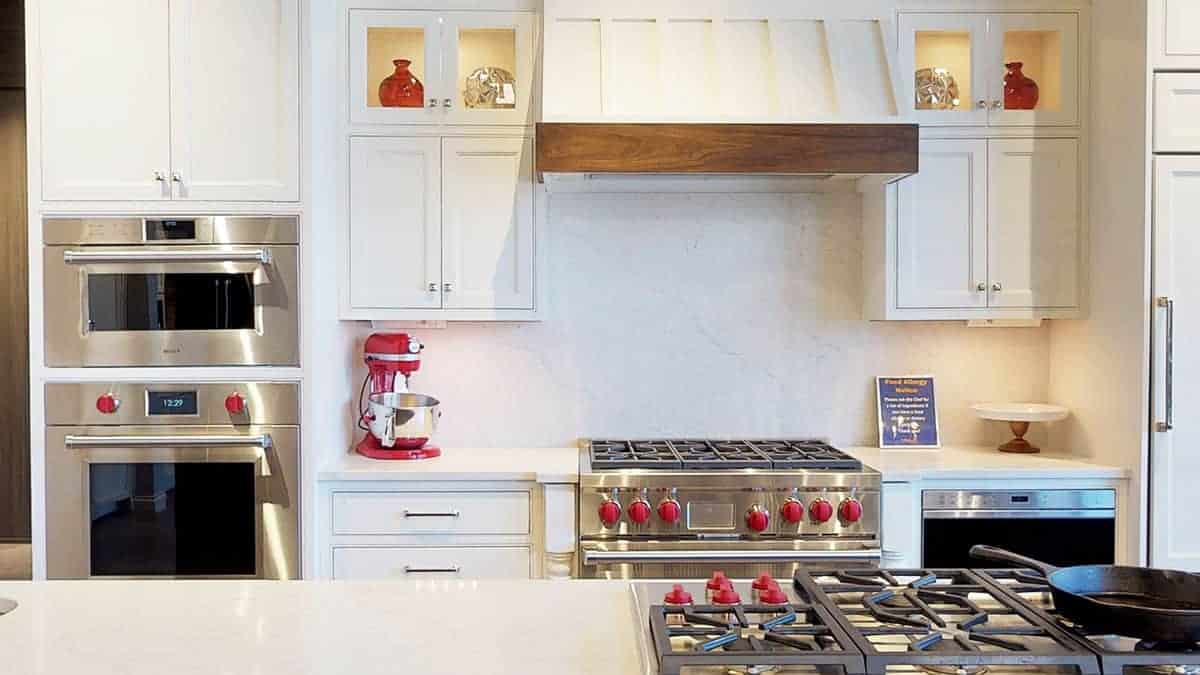
TL;DR: Best Steam Ovens for 2026
Gaggenau (precision control), Miele (guided cooking), Wolf (all-around ease), Thermador (largest capacity). For installs, choose plumbed in new builds and non-plumbed in remodels. For power, 220-volt heats faster and handles full meals.
✅ Gaggenau 400 Series: Precise humidity control; pro-level adjustments.
✅ Miele DGC 7780: MasterChef presets; easiest for first-time users.
✅ Wolf CSO3050TM: Simple, consistent, matches Wolf suites.
✅ Thermador PODS301W: 2.8 cu. ft.; best for large meals and entertaining.
This morning at 6 AM, I stared into the fridge and had two choices: reheat yesterday’s chicken or make something new for my daughter’s lunch.
I tossed the chicken and some rice into my Wolf steam oven and hit Reheat Humid.
Ten minutes later, it was hot, juicy, and tasted like I’d just made it.
That’s why steam ovens matter.
They don’t dry food out; they put the moisture back in. Vegetables stay vibrant. Chicken stays juicy. Even leftovers come back to life. All without extra oil or baking away nutrients.
In this guide, you’ll discover the four best steam ovens we’ve tested and installed across Greater Boston and Cape Cod, what they do best, what to avoid, and how to choose the one that fits your cooking style.
Let's get started.
📽️ Prefer a Video?
Watch our quick guide to the best steam ovens of 2026: Wolf for the easiest, automated cooking; Miele for intuitive, flexible control; Gaggenau for pro-level precision with multiple humidity settings and custom recipes.
Most people underuse steam ovens. See which fits your style, then attend a weekly demo to test it.
📌Skip Ahead:
The Best Steam Ovens for 2026
Top Picks at a Glance
| Steam Control | Guided Cooking | Plumbed | Size Options | Best For | Starting Price | |
| Gaggenau | Five levels, full manual | No | Yes | 245 and 30 inch | Experienced chefs who want full control | $9,899+ |
| Miele | 0 to 100 percent in 5 steps | Yes, MasterChef presets | Yes or no | XL and XXL | First time steam users and home chefs | $4,000 to $8,300 |
| Wolf | Automatic steam modes | Yes,Gourmet and Plus | Yes or No | 24 and 30 inch | Balanced use and ease of operation | Around $7,500 |
| Thermador | Basic fixed steam | No | No | 30 inch only | Large families and batch cooking | Around $6,050 |
1. Gaggenau BS485612 400 Series Combination Steam Oven ($9,899+)
Gaggenau BS485612 Review
This is our chefs’ favorite steam oven.
It is not the easiest to use or the least expensive, and it is not for everyone, or even most people.
If you are an experienced cook who wants total control over how steam interacts with your food, Gaggenau is in a category of its own.
It is the only steam oven that lets you control the percentage of humidity during any type of cooking.
The 30-inch 400 Series pairs beautifully above a wall oven and fits flush into cabinetry with a side-swing door.

Choose a left or right hinge when ordering; it is fixed and cannot be changed later.
Where most ovens offer vague settings like high, medium, or low, Gaggenau gives you five specific humidity levels you can adjust anytime during cooking.
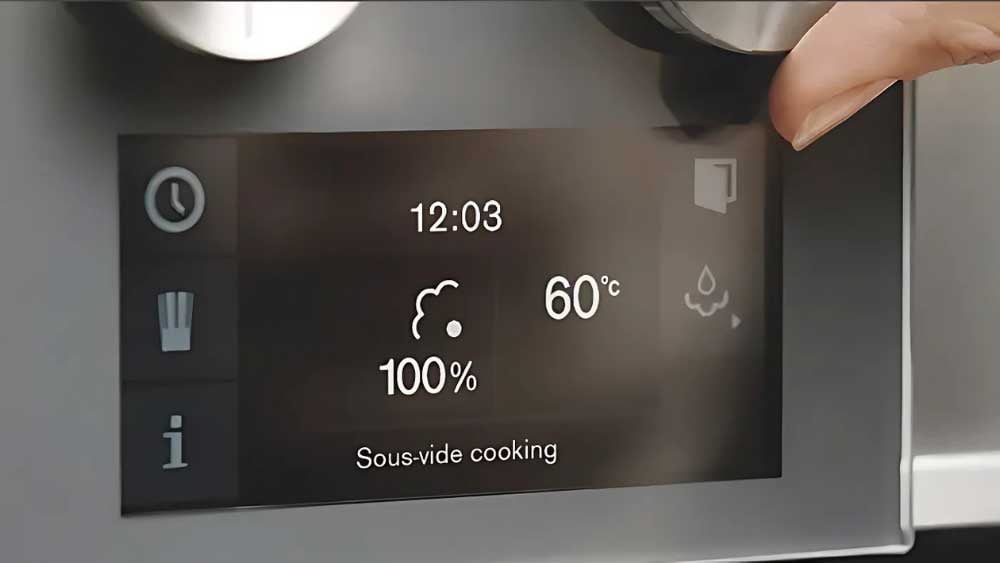
You can also switch from bake to broil mid-cycle, fine-tune the top and bottom heat, and store up to 50 custom or preset recipes for quick recall.
Drawbacks
It is not guided. There are no prompts and no recipes that think for you.
If you already know how to cook and want pro-level tools in your kitchen, this is the steam oven for you.
Key Features
- 30-inch 400 Series combination steam oven
- Flush install, side-swing door
- Choose fixed left or right hinge
- Pairs above a wall oven
- Five adjustable humidity levels
- Change humidity during cooking
- Switch bake to broil mid-cycle
- Fine-tune top and bottom heat
- Stores up to 50 recipes
- Only oven with humidity percentage control
Pros
✔️ Five humidity levels for precision steam
✔️ Adjust modes mid-cycle, including steam, bake, broil
✔️Top and bottom heat can be fine-tuned
✔️Stores 50 custom or preset recipes
✔️Side-hinged for access and symmetry
✔️Beautiful flush-mount fit and finish
Cons
❌ Steeper learning curve, no guided cooking
❌Expensive, starting around $9,899
❌Must choose left or right hinge
❌Not ideal for set-it-and-forget cooking
Bottom Line
If you are building a luxury kitchen and want full command over steam, temperature, and cooking modes, this is it.
Gaggenau is not for beginners, but in the right hands, it is unbeatable.
2. Miele 30-Inch Clean Touch Steam Oven DGC 7780 ($8,299)
Miele DGC 7780 Review
The MasterChef controls make this oven compelling.
Want to cook salmon? Hit a button. Baking bread? There is a preset for that too. You choose the food and how you want it cooked, and Miele takes care of the rest.
The beauty of this oven is its simplicity. You will use it easily without much of a learning curve.
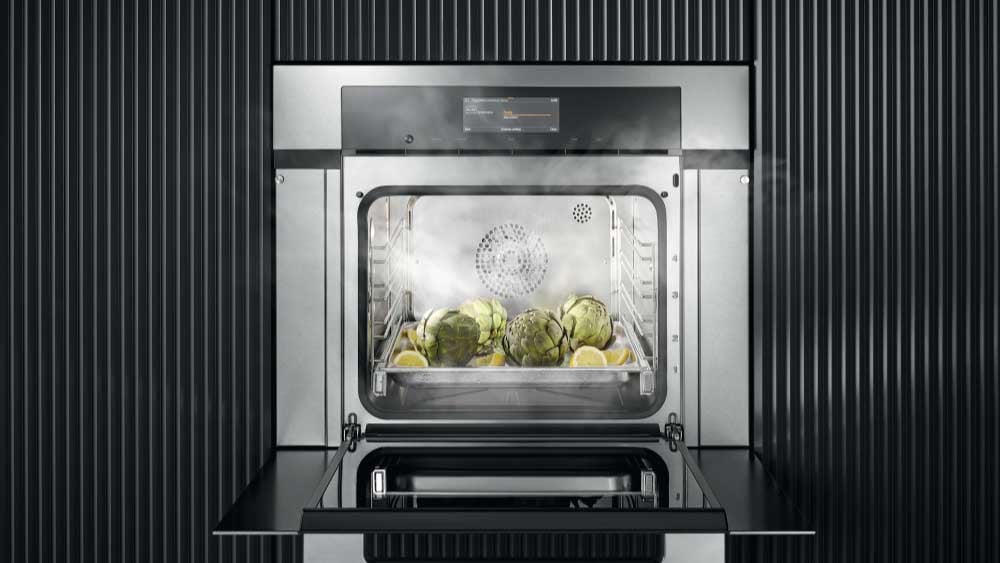
We see Miele steam ovens in homes across Brookline, Wellesley, and Chatham.
With both plumbed and non-plumbed options, it works well in new kitchens and remodels. And with larger XXL models, it is spacious enough for serious cooks.
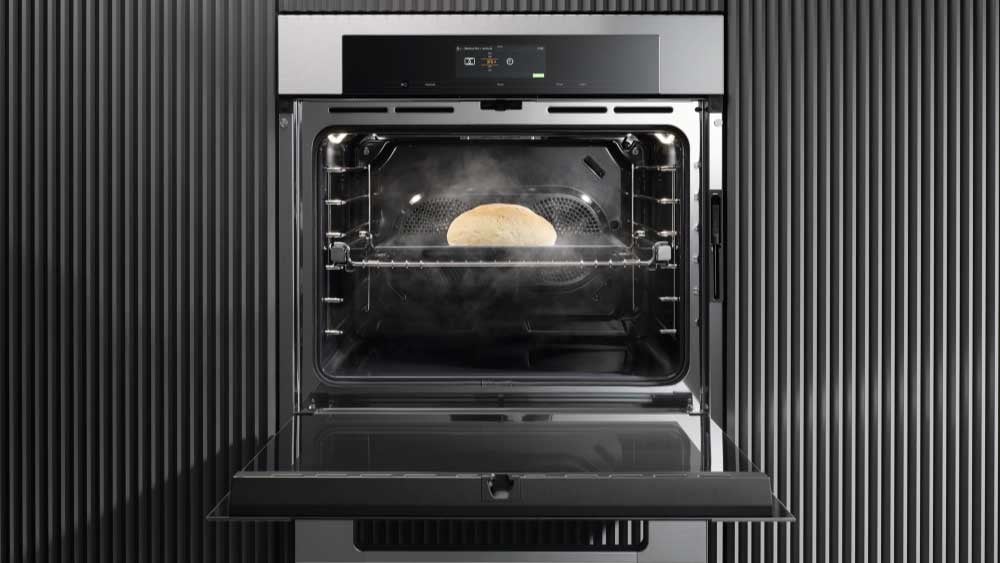
It also offers flexibility when you want more control. You can adjust steam from 0 to 100 percent in 5 percent steps. That is rare outside of professional-grade ovens.
Key Features
- MasterChef guided cooking with presets
- Simple, low learning curve
- Plumbed and non-plumbed options
- XL and XXL interior sizes
- 0 to 100 percent steam in 5 percent steps
- Bake, broil, convection, sous vide, steam modes
- WiFi app control
Pros
✔️ MasterChef guided cooking is intuitive and fast
✔️ Presets for salmon, bread, vegetables, and more
✔️0 to 100 percent manual steam control
✔️Available plumbed and non-plumbed options
✔️Spacious interior in XL and XXL sizes
✔️Includes bake, broil, convection, sous vide, steam
✔️WiFi app control
Cons
❌ Cannot change modes mid-cycle like Gaggenau
❌Larger models can get expensive
❌Touchscreen takes some exploring at first
Bottom Line
If you want to start steam cooking without overthinking it, Miele is the best place to begin. It is fast, flexible, and makes healthy cooking feel easy from the start.
3. Wolf M Series Wall Oven CSO3050TM (~$7,500)
Wolf CSO3050TM Review
Wolf’s steam oven is one of the most popular models we sell, and for good reason.
It is easy to use, has enough cooking modes to handle almost anything, and fits cleanly into modern and transitional kitchens.
The new 30-inch model comes in Professional, Transitional, and Contemporary styles, so you can match it with the rest of your Wolf appliances.
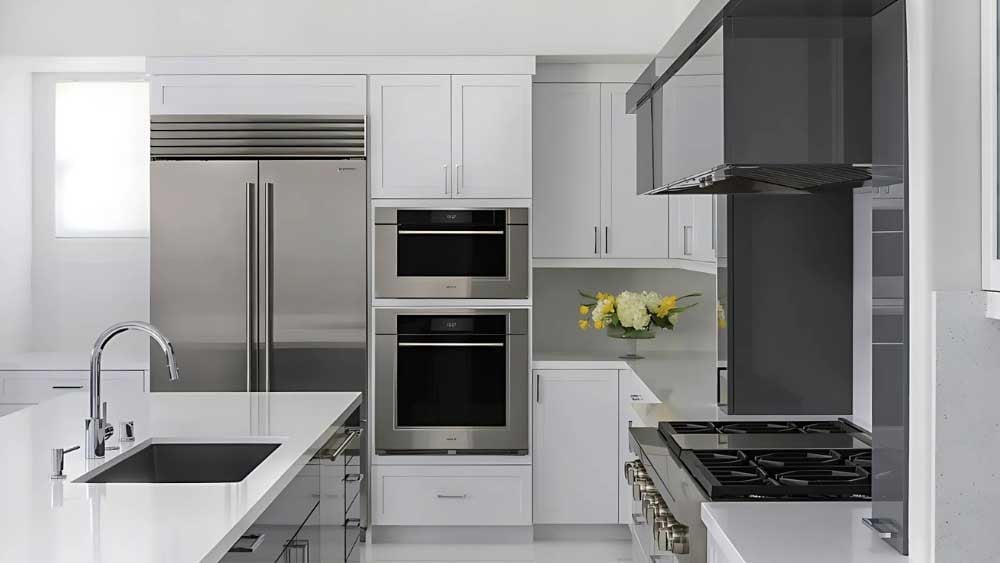
I have the Wolf steam oven at home. It is simple to use for almost everything. You can cook most foods automatically with the Gourmet and Gourmet Plus modes.
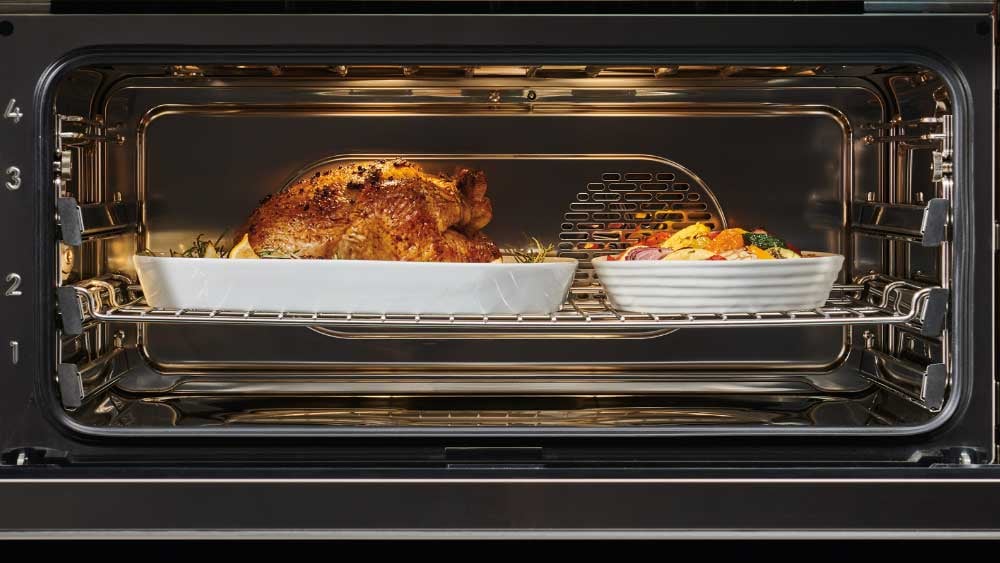
Here is a tip. You can reheat with three settings:
- Reheat uses steam and convection
- Reheat Crispy is great for meats
- Reheat Humid works best for pasta and rice
It is that simple. You can also store up to 50 personalized recipes and use the built-in temperature probe to alert you when your food is ready.
Key Features
- Simple touchscreen with guided cooking
- Three reheat modes: standard, Crispy, Humid
- Stores up to 50 personalized recipes
- Built-in temperature probe
- Slow roast, sous vide, bake, broil, reheat, proof
- 30-inch; Professional, Transitional, Contemporary styles
- Matches seamlessly with other Wolf appliances
Pros
✔️Simple touchscreen with guided cooking
✔️Moist and crispy settings for better results
✔️Stores up to 50 personalized recipes
✔️Built-in temperature probe
✔️Slow roast, sous vide, bake, broil, reheat, proof
✔️Matches seamlessly with other Wolf appliances
Cons
❌Less precise than Gaggenau for manual adjustments
❌Not a full main-oven replacement in most kitchens
❌Fewer advanced settings for experienced chefs
Bottom Line
Wolf gives you versatility without complication. If you want a steam oven that is easy to use, looks great, and performs consistently, this is one of the best choices on the market.
4. Thermador PODS301W Steam and Convection Oven ($6,499)
Thermador PODS301W Review
Thermador makes the largest residential steam oven on the market. At 2.8 cubic feet, it is big enough to cook a full roast, a side dish, and vegetables at the same time.
This oven is built for volume.
We see it in homes across Hingham, Winchester, and Wayland, often paired with a matching wall oven in a double-oven setup. It is a solid fit for large families or anyone who entertains often.
Thermador includes 41 automatic programs, 17 cooking modes, a built-in temperature probe, and a rotisserie that holds up to 12 pounds.
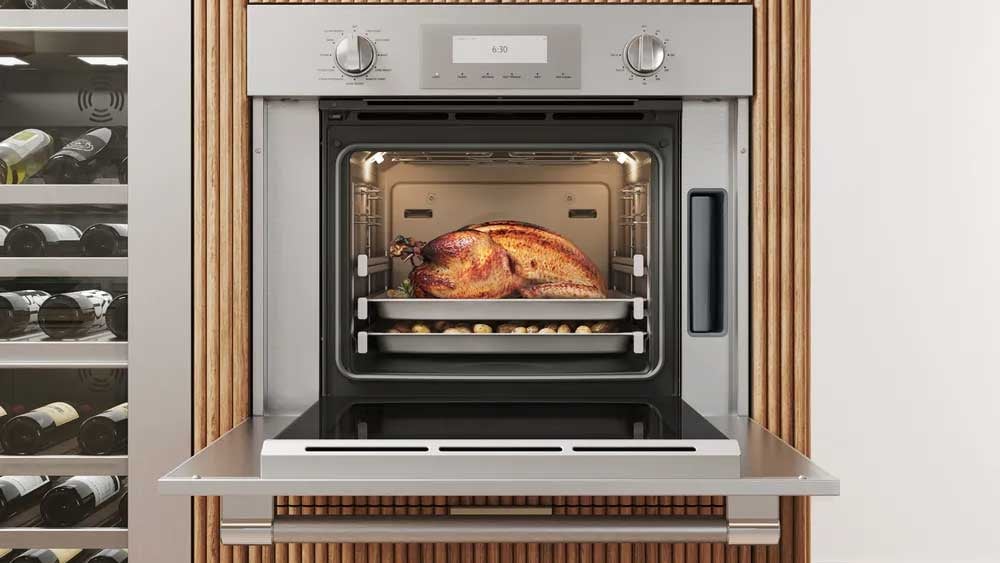
It preheats in about seven minutes and offers a self-cleaning mode for convenience.
It is not a smart oven. There is no guided cooking, no culinary center, and no sous vide.
You cannot switch modes mid-cycle, and there is no drain, so water collects at the bottom during steam cycles.
Key Features
- 2.8 cu. ft. capacity
- 41 automatic programs
- 17 cooking modes
- Built-in temperature probe
- Rotisserie up to 12 pounds
- Fast preheat, about seven minutes
- Self-cleaning mode
- Works well as double oven
- Masterpiece or Professional design
Pros
✔️ Largest steam oven at 2.8 cu. ft.
✔️41 automatic programs and 17 modes
✔️Includes broiler and rotisserie
✔️Fast preheat
✔️Works in double-oven configurations
✔️Stylish Masterpiece and Professional options
Cons
❌ No guided cooking or culinary center
❌No drain; water must be removed or baked off
❌No sous vide or humidity adjustment
❌Cannot switch modes mid-cycle
Bottom Line
If you cook in large quantities and need the space, Thermador is a reliable choice. You are trading capacity for features, which suits families and frequent hosts who value size over precision.
Should You Choose a Plumbed or Non-Plumbed Steam Oven?
Quick Answer: Plumbed for new builds; non-plumbed for remodels. Refresh the tank after each use.
Plumbed steam ovens connect directly to your water line.
You never have to refill them. They are great for longer recipes, multiple meals in a row, or if you want one less thing to think about.
Non-plumbed ovens use a refillable tank. You just top it off when needed. It is simple and flexible, especially for remodels or spaces where plumbing is not possible.
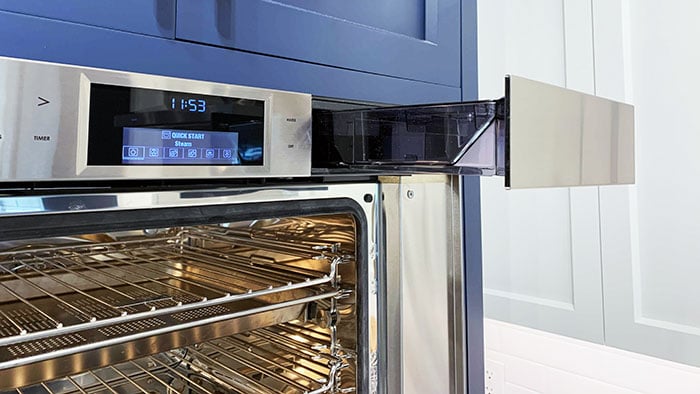
What we see: Most people in new construction go plumbed. If you are replacing an appliance in an existing kitchen, non-plumbed is usually easier and more cost-effective.
I have a non-plumbed model, by the way, and have never run out of steam. I also do not worry about leaks because I am always adding water.
Here is an interesting tip for non-plumbed units: Always refresh the water after each use. Standing water can be a breeding ground for bacteria.
Should You Buy a 110-Volt or 220-Volt Steam Oven?
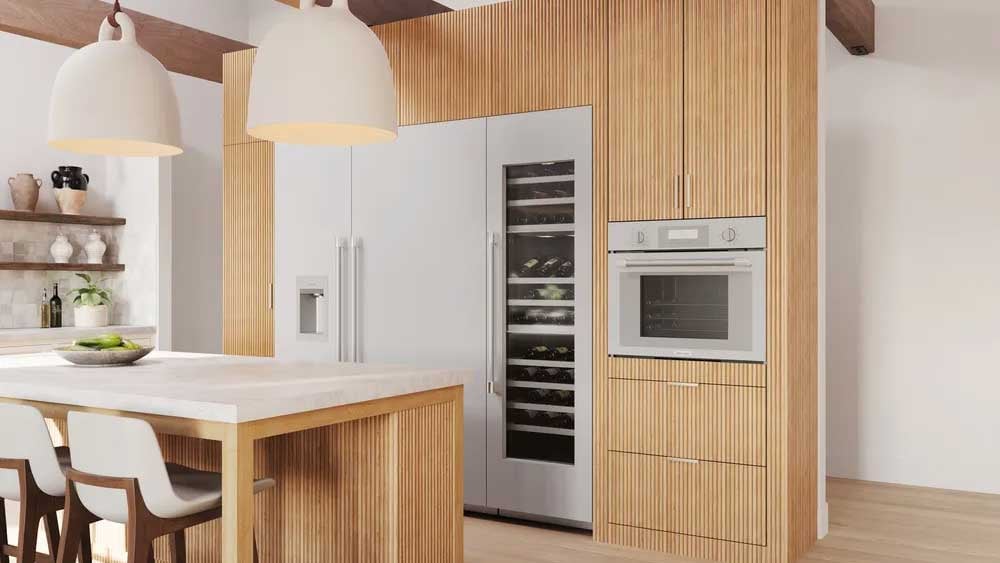
Quick answer: 110-volt suits light reheating. 220-volt heats faster and handles full meals; it’s our pick for most homes.
110-volt steam ovens plug into a standard outlet. They are easier to install and work well for reheating, vegetables, and lighter use.
If you are replacing a microwave, this is often the way to go.
220-volt ovens heat faster, hold temperature better, and handle heavier cooking like roasting, baking, or full meals.
What we recommend: Go 220 volt. 110 volts will never give you the full benefit of a steam oven.
Which Steam Oven Is Best for You?
Quick answer: Match the brand to your cooking style and space. Confirm your choice with a live demo.
Steam ovens are one of the most useful appliances you can add to your kitchen.
They cook healthier meals, reheat better than a microwave, and once you learn to use one, you will probably use it every day.
So which one is right for you?
- If you want total control, Gaggenau is the most advanced. You can fine-tune every setting, adjust humidity, and cook like a professional. But it is not for beginners.
- If you want something easy to use right away, Miele is the best starting point. MasterChef lets you tap a button and walk away. It is the most approachable steam oven by far.
- If you want a balance of both, Wolf is the most popular choice in our showrooms. It is easy, consistent, and has enough customization to grow with you.
- If you cook for a crowd, Thermador gives you space. It is not the smartest oven, but it is the biggest.
Before you decide, come try one in person. We have live steam ovens in all six of our showrooms across Boston, Framingham, Hanover, Hyannis, Norton, and Nantucket.
Our team can show you how they work, help you pick the right one, and make sure it is installed and supported the right way.
Additional Resources
Get the Speed and Steam Oven BuyingGuide with features, specs and inside tips to all the steam and speed ovens like Wolf, JennAir, Thermador, Gaggenau, and more. Well over 1 million people have read a Yale Guide.
Related Articles:
- Wolf vs. Miele Steam Ovens: Which Is Better?
- Thermador vs. Miele Steam Ovens
- Gaggenau vs. Miele Steam Ovens
- Everything You Can Cook in a Steam Oven
- 5 Healthy Meals You Can Make in a Steam Oven
- Speed Ovens vs. Steam Ovens: Which Should You Buy?
Recent Posts
Why Should You Trust Us?
It seems that every appliance review has nothing but glowing comments about almost every product, yet you read customer reviews and they are almost universally bad.
We are here to fill in the disconnect. We'll give you the best features, and the drawbacks as well, including reliability based on over 37,000 calls performed by our service team just last year. Our goal is to give you ALL the information so you know what's right for you.
Please consider subscribing or adding to the conversation in the comments below. We appreciate you stopping by.
Steve Sheinkopf is the third-generation CEO of Yale Appliance and a lifelong Bostonian. He has over 38 years of experience in the appliance industry, and he is a trusted source of information for consumers on how to buy and repair appliances.
Steve has also been featured in numerous publications, including the
New York Times,
Consumer Reports,
The Boston Globe,
Bloomberg Radio, the
New York Post,
The Wall Street Journal, and
Entrepreneur, for his knowledge of how to buy appliances and appliance repair.
Steve is passionate about helping consumers find the best appliances for their needs, and he is always happy to answer questions and provide advice. He is a valuable resource for consumers who are looking for information on appliance buying, repair, and maintenance.
Despite being the worst goalie in history, Steve is a fan of the Bruins and college hockey, loves to read, and is a Peloton biker. The love of his life is his daughter, Sophie.
A Note About Pricing
Pricing on this blog is for reference only and may include time sensitive rebates. We make every attempt to provide accurate pricing at time of publishing. Please call the stores for most accurate price.
Topics:


